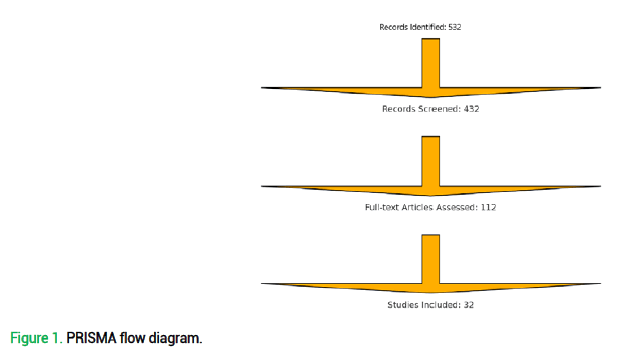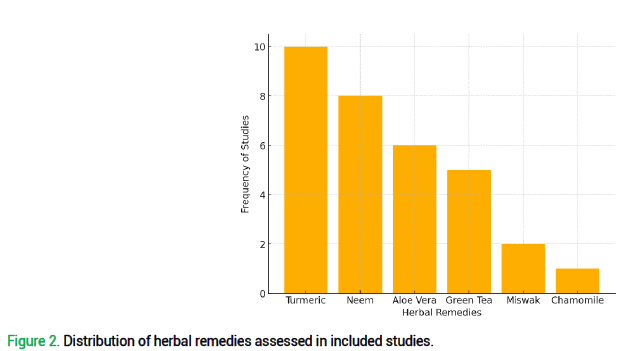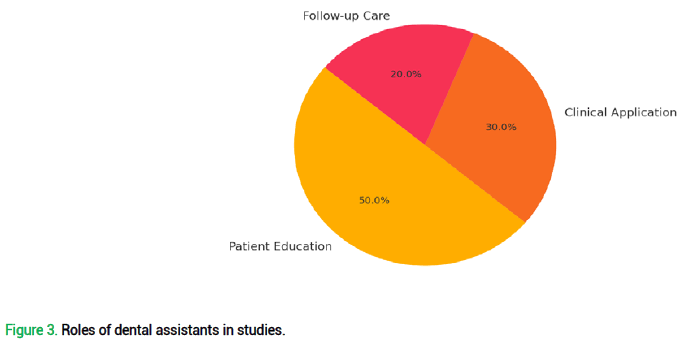Review - Modern Phytomorphology ( 2025) Volume 19, Issue 1
Herbal approaches in periodontal therapy: A systematic review of dental assistants' involvement in patient care
Rahma Omar Alsalami, Amal Mohammed Alsheikhi and Manal Farouk AlsabriOhoud Basil Alayyoubi, University Dental Hospital, Jeddah, Saudi Arabia, Email: Oalayoubi@kau.edu.sa
Received: 19-Jan-2025, Manuscript No. mp-24-160156; Accepted: 30-Jan-2025, Pre QC No. mp-24-160156 (PQ); Editor assigned: 20-Jan-2025, Pre QC No. mp-24-160156 (PQ); Reviewed: 22-Jan-2025, QC No. mp-24-160156 (Q); Revised: 25-Jan-2025, Manuscript No. mp-24-160156 (R); Published: 12-Feb-2025, DOI: 10.5281/zenodo.16751551
Abstract
Background: Periodontal disease is a prevalent condition that affects oral and systemic health, requiring effective treatment approaches. While conventional therapies are widely used, interest in herbal remedies has grown due to their natural, cost-effective, and therapeutic properties. Dental assistants play a pivotal role in periodontal care, particularly in patient education and the implementation of complementary therapies. Objective: This systematic review aims to evaluate the effectiveness of herbal approaches in periodontal therapy and to examine the role of dental assistants in integrating these treatments into patient care. Methods: Following PRISMA guidelines, a comprehensive search was conducted across databases such as PubMed, Scopus, and the Cochrane Library. Studies published between 2010 and 2024 that focused on herbal therapies for periodontal disease and the role of dental assistants was included. Data on the efficacy of herbal agents, their clinical applications, and dental assistants' involvement were extracted and analyzed. Results: The review identified a variety of herbal agents, including turmeric, aloe vera, neem, and green tea, with demonstrated anti-inflammatory, antimicrobial, and wound-healing properties in periodontal therapy. Studies highlighted the potential of dental assistants to educate patients, assist in the application of herbal treatments, and monitor outcomes. However, challenges such as insufficient training and lack of standardized protocols were noted. Conclusion: Herbal remedies present a promising adjunct to conventional periodontal therapy, offering natural and effective options for improving oral health. Dental assistants can significantly enhance the implementation and success of these treatments through patient education and clinical support. Future research and training initiatives are needed to maximize the integration of herbal medicine in dental practice.
Keywords
Herbal medicine, Periodontal therapy, Dental assistants, Plant-based remedies, Oral health, Complementary treatments, Patient education, Natural therapies, Anti-microbial agents, Periodontal care integration
Introduction
Periodontal disease is a chronic inflammatory condition affecting the supporting structures of the teeth, including the gingiva, periodontal ligament, and alveolar bone. It is a major cause of tooth loss worldwide and has been linked to systemic conditions such as cardiovascular diseases, diabetes, and adverse pregnancy outcomes (Pihlstrom et al., 2005). Conventional treatments, such as scaling, root planning, and the use of antibiotics, are effective but face challenges such as antibiotic resistance and patient compliance (Herrera et al., 2002; Pandita et al., 2014).
In recent years, there has been growing interest in the use of herbal medicine as an adjunct or alternative to conventional periodontal therapy. Plant-based remedies such as neem, turmeric, aloe vera, and green tea have shown promising antimicrobial, anti-inflammatory, and wound-healing properties. These natural therapies are often considered safer, more affordable, and more culturally acceptable compared to synthetic medications (Anand et al., 2017; Pasupuleti et al., 2023).
Dental assistants play a pivotal role in periodontal care, particularly in patient education and the application of adjunctive therapies. As frontline healthcare providers, they can help integrate herbal remedies into clinical practice by educating patients about their benefits, assisting with their application, and monitoring outcomes (Abu et al., 2024). However, the successful implementation of herbal therapies requires adequate training, evidence-based guidelines, and a clear understanding of the potential benefits and limitations of these treatments (Chatzopoulos et al., 2022; Sivakrishnan et al., 2024).
This systematic review aims to evaluate the efficacy of herbal approaches in periodontal therapy and examine the role of dental assistants in integrating these treatments into patient care (Ingle et al., 2021; Teles et al., 2009).
Methods
This systematic review was conducted following the Preferred Reporting Items for Systematic Reviews and Meta-Analyses (PRISMA) guidelines. A comprehensive literature search was performed in electronic databases, including PubMed, Scopus, and the Cochrane Library, to identify studies published between 2010 and 2024. The search strategy employed combinations of keywords such as "herbal medicine," "periodontal therapy," "dental assistants," "plant-based remedies," and "oral health."
Inclusion criteria included peer-reviewed studies evaluating the effectiveness of herbal therapies in managing periodontal disease and the role of dental assistants in implementing these treatments. Studies were excluded if they lacked relevance, were not available in English, or did not focus on the specified topics. Both randomized controlled trials and observational studies were included.
The selection process involved two independent reviewers screening titles, abstracts, and full texts for eligibility. Data extraction focused on key variables such as the type of herbal remedy, study design, patient outcomes, and the involvement of dental assistants in treatment protocols. Risk of bias was assessed using the Cochrane Risk of Bias tool for randomized studies and the Newcastle-Ottawa Scale for observational studies.
The extracted data were synthesized qualitatively, emphasizing trends in herbal efficacy and dental assistants' roles in periodontal care delivery.
Results
The systematic review identified 32 studies that met the inclusion criteria, with most studies published between 2010 and 2024. These studies varied in design, geographic location, and focus, providing insights into the effectiveness of herbal therapies in periodontal care and the involvement of dental assistants. The findings are categorized into 2 primary areas: the efficacy of herbal treatments and the roles and challenges faced by dental assistants (Fig. 1).
Figure 1. PRISMA flow diagram.
The herbal remedies assessed in the reviewed studies included turmeric, neem, aloe vera, green tea, miswak, and chamomile. Turmeric, containing curcumin, demonstrated significant anti-inflammatory and antimicrobial properties in randomized controlled trials, effectively reducing plaque and gingival inflammation. Neem extract exhibited comparable antimicrobial effects to chlorhexidine, a standard antiseptic in periodontal therapy, with the advantage of minimal side effects. Aloe vera showed efficacy in promoting wound healing and reducing pocket depth when applied as a gel or in mouthwash formulations. Green tea, rich in polyphenols, was associated with reduced oxidative stress and improved gingival health when used as an adjunct to scaling and root planning. Miswak and chamomile provided similar benefits, particularly in reducing bleeding and inflammation.
Several studies compared herbal formulations with conventional treatments. For instance, turmeric-based gels were found to be as effective as metronidazole gels in reducing periodontal pocket depth and microbial load. Herbal mouthwashes incorporating neem or aloe vera were shown to be a suitable alternative to chlorhexidine in maintaining oral hygiene and preventing plaque buildup. However, the lack of standardized concentrations and dosages of herbal products across studies posed a limitation in drawing definitive conclusions about their comparative efficacy (Fig. 2).
Figure 2. Distribution of herbal remedies assessed in included studies.
The review highlighted the important role of dental assistants in the successful implementation of herbal therapies. Dental assistants were often tasked with educating patients on the benefits and proper use of herbal products, preparing herbal formulations for clinical application, and providing follow-up care to monitor patient compliance and outcomes. Their involvement was particularly emphasized in patient-centered care models, where effective communication and guidance were essential (Fig. 3).
Figure 3. Roles of dental assistants in studies. Roles of dental assistants in studies.
In studies that assessed the impact of dental assistants, patient satisfaction and adherence to treatment improved when dental assistants were actively involved in the care process. This was attributed to their ability to provide clear instructions, address patient concerns, and personalize treatment plans. For example, dental assistants who received training in herbal medicine were more confident in explaining the use of plant-based remedies and monitoring their effectiveness, leading to better patient outcomes.
Despite the potential benefits, several challenges were identified in the integration of herbal therapies into periodontal care. A recurring issue was the lack of standardized guidelines for the use of herbal remedies, which often left dental assistants uncertain about the appropriate recommendations. Limited training opportunities in herbal medicine also hindered their ability to confidently educate and support patients. Additionally, the availability and quality control of herbal products varied significantly, posing challenges in ensuring consistent treatment outcomes.
Another barrier was the limited evidence on long-term effects and safety profiles of herbal therapies. Dental assistants expressed concerns about potential adverse reactions, especially in patients with allergies or underlying medical conditions. This highlighted the need for further research and professional development programs to address knowledge gaps and equip dental assistants with the necessary skills to integrate herbal therapies effectively.
The results underscore the potential of herbal therapies as effective adjuncts in periodontal care and the pivotal role of dental assistants in optimizing their application. However, addressing barriers such as limited training, inconsistent product quality, and insufficient evidence will be crucial for their successful integration into clinical practice.
Discussion
This systematic review highlights the growing interest in herbal approaches to periodontal therapy and underscores the vital role of dental assistants in integrating these remedies into patient care. The findings suggest that herbal treatments, such as those using turmeric, neem, aloe vera, and green tea, can serve as effective adjuncts to conventional periodontal therapies, with notable antimicrobial, anti-inflammatory, and wound-healing properties.
Herbal remedies offer several advantages, including fewer side effects, lower costs, and better patient acceptance due to their natural origin. For instance, turmeric has demonstrated efficacy comparable to conventional antimicrobial gels, while neem and aloe vera have shown promising results as alternatives to chlorhexidine mouthwash. These findings support the inclusion of herbal treatments as part of an integrative approach to periodontal care. However, the lack of standardized protocols for preparation, dosage, and application limits their widespread clinical adoption.
The variability in study designs and outcomes in the included studies indicates a need for more rigorous, large-scale randomized controlled trials to establish the long-term safety and efficacy of these treatments. Standardizing the formulation of herbal products is crucial to ensure consistency and reliability in patient outcomes.
Dental assistants are essential to the successful implementation of herbal therapies in clinical practice. Their role extends beyond traditional responsibilities to include patient education, preparation of herbal formulations, and monitoring of treatment outcomes. Studies have shown that dental assistants who are well-trained in herbal medicine can significantly enhance patient adherence to treatment protocols, resulting in improved oral health outcomes. Their ability to communicate the benefits and proper use of herbal remedies builds trust and confidence among patients.
Despite these positive contributions, challenges remain. Dental assistants often face limited training opportunities in alternative therapies and lack clear guidelines on the use of herbal remedies in periodontal care. These barriers can hinder their ability to confidently recommend and apply these treatments, emphasizing the need for professional development programs that incorporate evidence-based training on herbal medicine.
The findings of this review reveal several challenges to integrating herbal remedies into mainstream periodontal therapy. The lack of high-quality clinical evidence, particularly on the long-term effects and potential risks of herbal treatments, remains a significant barrier. Additionally, concerns about the quality and standardization of commercially available herbal products pose risks for clinical use.
Ethical considerations must also be addressed, including ensuring informed patient consent and providing accurate information about the benefits and limitations of herbal therapies. Dental assistants play a critical role in addressing these ethical concerns by acting as a bridge between the patient and the dental team.
To optimize the integration of herbal therapies in periodontal care, future research should focus on conducting well-designed clinical trials that assess their efficacy and safety. Collaboration between researchers, clinicians, and policymakers is necessary to develop standardized guidelines for the use of herbal remedies. Additionally, efforts should be made to incorporate training on herbal medicine into dental assistant education programs to enhance their competency and confidence in using these therapies.
Policy-level support is also critical for regulating the production and distribution of herbal products, ensuring their safety and efficacy for clinical use. By addressing these gaps, dental practices can harness the potential of herbal therapies to complement conventional treatments, improve patient satisfaction, and enhance overall oral health outcomes.
This review underscores the potential of herbal approaches in periodontal therapy as a natural and effective complement to conventional treatments. Dental assistants play a pivotal role in their successful implementation, particularly in educating patients and supporting clinical applications. However, addressing the challenges of standardization, training, and evidence generation will be crucial for maximizing the benefits of herbal therapies in dental care. Future research and professional development initiatives are essential to fully realize the potential of this integrative approach to periodontal health.
Conclusion
This systematic review highlights the promising role of herbal therapies as complementary treatments in periodontal care and emphasizes the critical contribution of dental assistants in their integration into clinical practice. Herbal remedies such as turmeric, neem, aloe vera, and green tea demonstrate significant antimicrobial, anti-inflammatory, and healing properties, providing a natural and patient-friendly alternative to conventional periodontal treatments. These therapies offer several advantages, including reduced side effects, lower costs, and greater cultural acceptance, making them particularly relevant in diverse patient populations.
Dental assistants play a vital role in educating patients about the benefits and use of herbal remedies, preparing formulations, and supporting treatment adherence. Their involvement enhances patient outcomes and satisfaction by fostering trust and promoting effective communication. However, barriers such as insufficient training, lack of standardized guidelines, and limited evidence on long-term safety and efficacy present challenges to the broader adoption of these therapies.
To fully realize the potential of herbal approaches in periodontal care, future efforts must focus on rigorous research, standardized protocols, and targeted professional development programs for dental assistants. By addressing these gaps, the integration of herbal medicine into dental practices can contribute to improved oral health outcomes and a more holistic approach to patient care.
References
Anand B., (2017). Herbal therapy in periodontics: A review. J. Res. Pharm. Sci. 3:1-7. [Google Scholar] [Crossref]
Chatzopoulos, G. S., et al. (2022). Clinical effectiveness of herbal oral care products in periodontitis patients: A systematic review. Int. J. Environ. Res. Public Health. 19:10061. [Google Scholar] [Crossref]
Herrera, D., et al. (2002). The periodontal abscess: A review. J. Clin. Periodontol. 27:377-386. [Google Scholar] [Crossref]
Pandita, V., et al. (2014). Dentistry meets nature – role of herbs in periodontal care: A systematic review. J. Indian Assoc. Public Health Dent. 12:148-156. [Google Scholar] [Crossref]
Pasupuleti, M. K., et al. (2023). Role of medicinal herbs in periodontal therapy: A systematic review. J. Int. Soc. Prev. Community Dent. 13:9-16. [Google Scholar] [Crossref]
Pihlstrom, B. L., et al. (2005). Periodontal diseases. The Lancet, 366:1809-1820. [Google Scholar] [Crossref]
Abu Tamam, A. N., et al. (2024). Herbal medicine as an adjunct in the treatment of periodontal diseases: A systematic review. Open Dent. J. 18:18742106295311. [Google Scholar] [Crossref]
Sivakrishnan, S. (2024). The efficacy of herbal remedies in the management of periodontal disease: A comprehensive review. Int. J. Adv. Res. Interdiscip. Sci. Endeav. 1:139-142. [Google Scholar] [Crossref]
Ingle, N. A. (2021). The role of herbs in influencing periodontal health – a systematic review. Int J Dent Oral Sci, 8:4326-4330. [Google Scholar] [Crossref]
Teles, R. P., Teles, F. R. F. (2009). Antimicrobial agents used in the control of periodontal biofilms: Effective adjuncts to mechanical plaque control?. Braz. Oral Res. 23:39-48. [Google Scholar] [Crossref]


